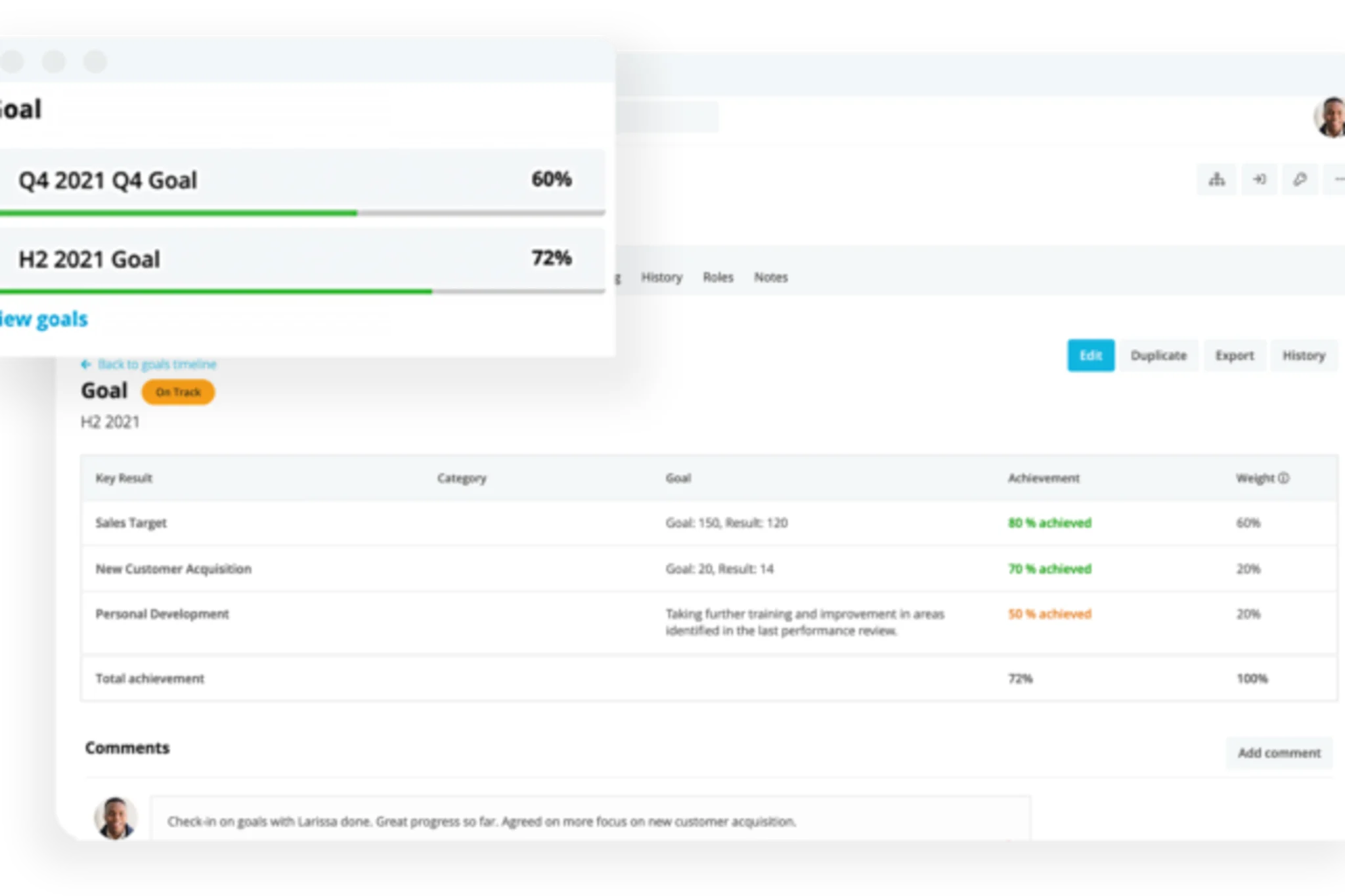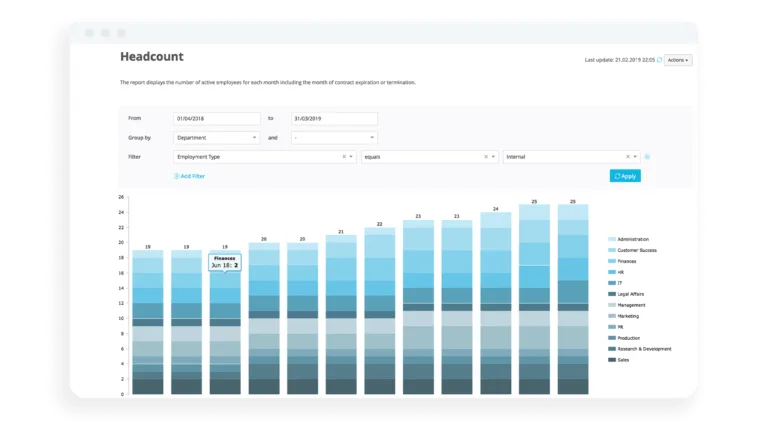Employee Engagement: HR’s Underestimated Revenue Driver

Measuring employee engagement goes way beyond measuring for a vanity metric. If you do it correctly, it can become a key element of your company’s success.
When you systematically evaluate employee engagement, you give employees a voice, make negative trends visible in time, and increase both team productivity and company performance.
In this article, I want to share how I view employee engagement, how to develop a strategy for measuring it, and what KPIs we focus on here at Personio. Enjoy! – Ross Seychell, Chief People Officer at Personio
Looking to measure employee engagement through a survey? Download our free template today.Employee Engagement: A Primer
Before we begin, I want to point you in the direction of some very helpful resources related to the overall topic of employee engagement. If you want to learn more about it, before we dig into measuring it, here is where you should head:
All that said and done, let’s kick things off with the all-important question: Should your team be measuring employee engagement in the first place? And, why?
Should Your Team Be Measuring Employee Engagement?
We can view employee engagement as a barometer for so much of what goes in within your organization. It can show you when things are running smoothly, while helping you prepare for any potential issues before they ever reveal themselves.
In fact, studies show that motivated employees are up to 22% more productive, making their companies more profitable. According to a survey by Gallup, companies with highly engaged employees generated around 147% higher earnings per share than companies where motivation left much to be desired.
What are the benefits of measuring employee engagement?
Giving employees a voice
Understanding trends
Identifying problems early and taking countermeasures
Preventing employee turnover
Increasing business performance
As a key performance indicator (KPI), employee engagement shows how your employees think and feel about your company. If you don’t measure employee engagement, you run the risk of a drop in morale, a loss of team loyalty, and even sudden resignations.
Therefore, measuring your employee engagement has a strategic impetus, because the key figure is directly related to the company’s success. Since HR departments should act as partners to management – after all, they "control" the most important corporate resource, the employees – they must keep firm watch over this key figure.
Measuring Employee Engagement: A Framework
To measure employee engagement, you should first ask yourself three essential questions.
Why – What is the overall goal of measuring your employee engagement?
What – What data do you want to measure, and what data do you already have access to versus what data can you get?
How – How will you collect the data and how will you analyze it?
At Personio, an important “why” is related to our rapid growth, because while we want to scale, we also want to preserve our company culture. So, we pay close attention to how the mood of the team changes: Are people still happy or are there growing pains somewhere?
To do this, we look at various metrics all along our Candidate and Employee Journey.
The crux, however, lies in the actual measurement. Companies like Microsoft are increasingly relying on the analysis of indirect data sources: For example, they evaluate the volume of e-mail traffic in teams as a sign of commitment and job satisfaction.
A counter to purely data-driven analysis is an employee survey. In fact, at Facebook, this provided more than twice the accuracy in predicting employee resignations than an analytical approach tied to Big Data.
At Personio, we rely on a combination of classic methods, such as surveys, and machine-based methods. For most analyses, we use the reports that can be found in our software, Personio.
This reporting helps us to better understand and visualize data. We have also connected the CultureAmp feedback platform to Personio. Using this tool, we conduct regular Pulse Checks and Engagement Surveys, in which we ask specific questions about employee motivation.
The 5 Most Important HR KPIs For Employee Engagement
Let’s address today’s core question: What exactly should be measured to determine employee engagement? Building on that, which metrics deserve special attention?
There are countless KPIs that are mindful of employee engagement – from the number of trainings booked, to the company’s rating on review portals like Glassdoor.
At Personio, we look at the following five metrics:
1. Engagement Index
We derive this metric from our regular Engagement Survey. We want to understand how our team thinks and feels about Personio. So, we ask questions around the core topics of pride, endorsement, motivation, and current and future commitment.
Employees are asked to rank themselves on a scale of 1 to 5 relating to each topic. All told, this method combines elements of behavioural research with principles from our corporate culture.
Examples of questions:
“I am proud to work at Personio.” (Pride)
“I see myself working at Personio in two years.” (Future Commitment)
Next, we evaluate the score per core theme. We look at how the score has changed from the previous survey and look at which topics and questions were rated particularly high by each department. This way, we know where we need to focus our efforts.
2. Voluntary Attrition
A moderate change in the team is normal and can even bring with it new momentum. That said, too many resignations are a warning sign. That’s why we use our reports in Personio to look at the number of employees who have left the company of their own accord. This gives us valuable clues about the mood and motivation across every part of the organization.
3. Early Attrition
If employees quit shortly after joining the company, this is a direct indication that the job did not meet their expectations or that they did not feel comfortable in the team. Our goal is to inspire new hires so that they are motivated and committed to their tasks. If the early attrition rate is too high, we have to make adjustments.
4. Absenteeism Rates
It’s a similar story with absenteeism. If your absenteeism rates suddenly spike in certain teams or departments, demotivation or lack of engagement may be the cause. As is the case with previously mentioned metrics, we also keep an eye on this one within Personio’s reporting feature.
5. Productivity
Our employees have different goals: Those that contribute to cross-departmental and cross-company goals and those that serve personal career development. In regular feedback meetings, direct supervisors evaluate all development steps, and twice a year there is an employee appraisal. Based on the results, we can calculate productivity within the company.
We also take time to actively look at metrics that show our performance and effectiveness as a team. It’s important that we get to the bottom of understanding how efficiently we run our operational tasks, especially across our HR, Office IT, and Recruiting departments.
Gaining Insights, Deriving Measures
After the time we take to collect and calculate a number of key metrics, we need to work with them. More specifically, we need to construct measures that support employee engagement in the places where they’ll have the most impact.
As strategic partners with management, we prepare a detailed overview on a quarterly basis: In it, we dive deep into recruiting and HR data. We highlight changes and trends that the management team uses for their quarterly business review. We also ensure that executives can access the monthly numbers, at a glance, in a helpful dashboard.
We also rely on employee engagement metrics in our team’s development of annual strategy and our semi-annual OKRs. We form hypotheses about where we need to focus in the Candidate and Employee Journey. This enables us to take immediate action even in the event of unanticipated changes.

About Ross Seychell
As a business leader with 20 years of HR experience, I have a strong passion for how a company’s most important asset – their people and culture – enables them to unlock and achieve their mission. After building out workplace strategies at high-growth companies such as Wise and King, I joined Personio as Chief People Officer to help us become the leading HR platform and tech employer in Europe.



